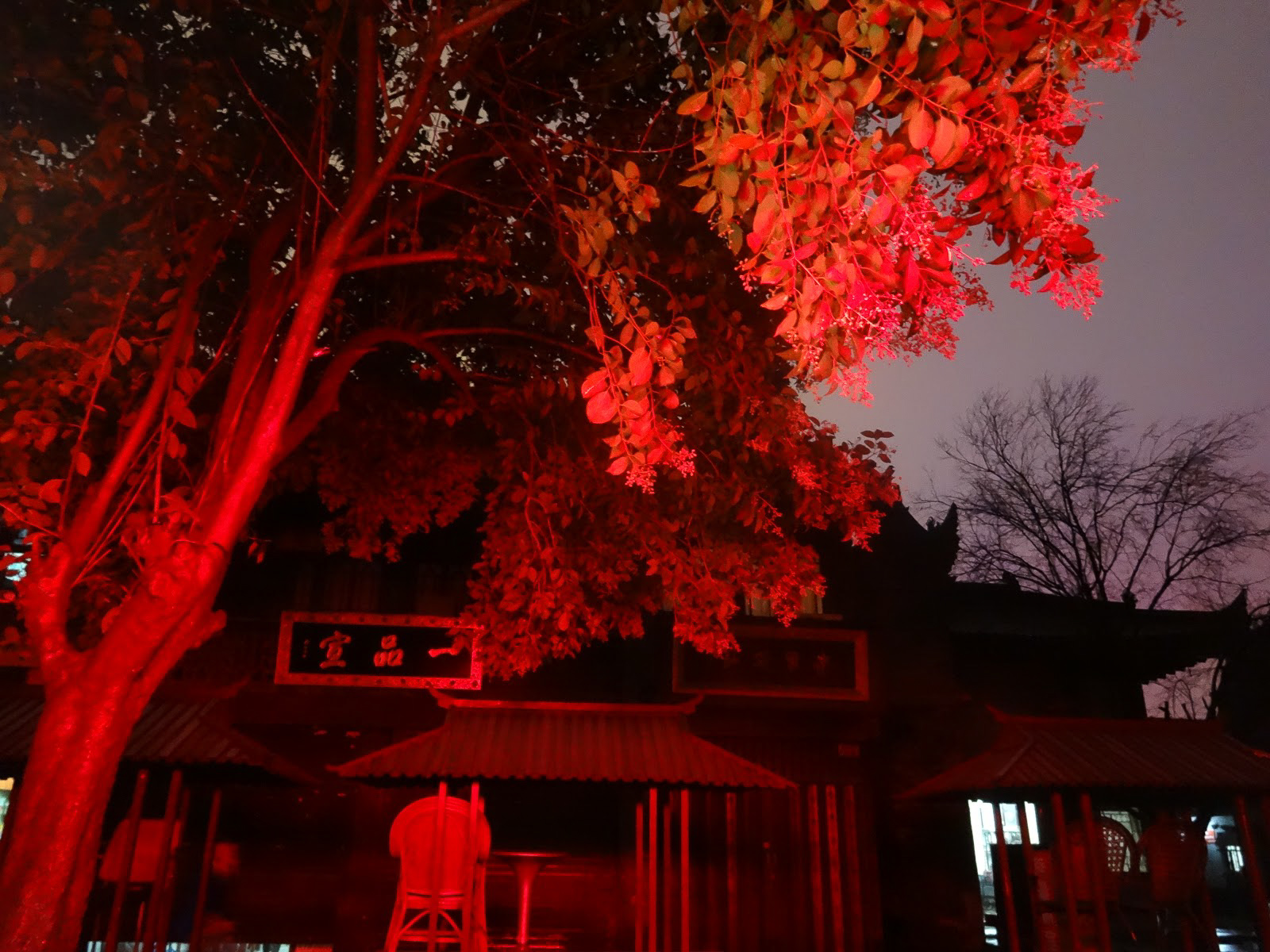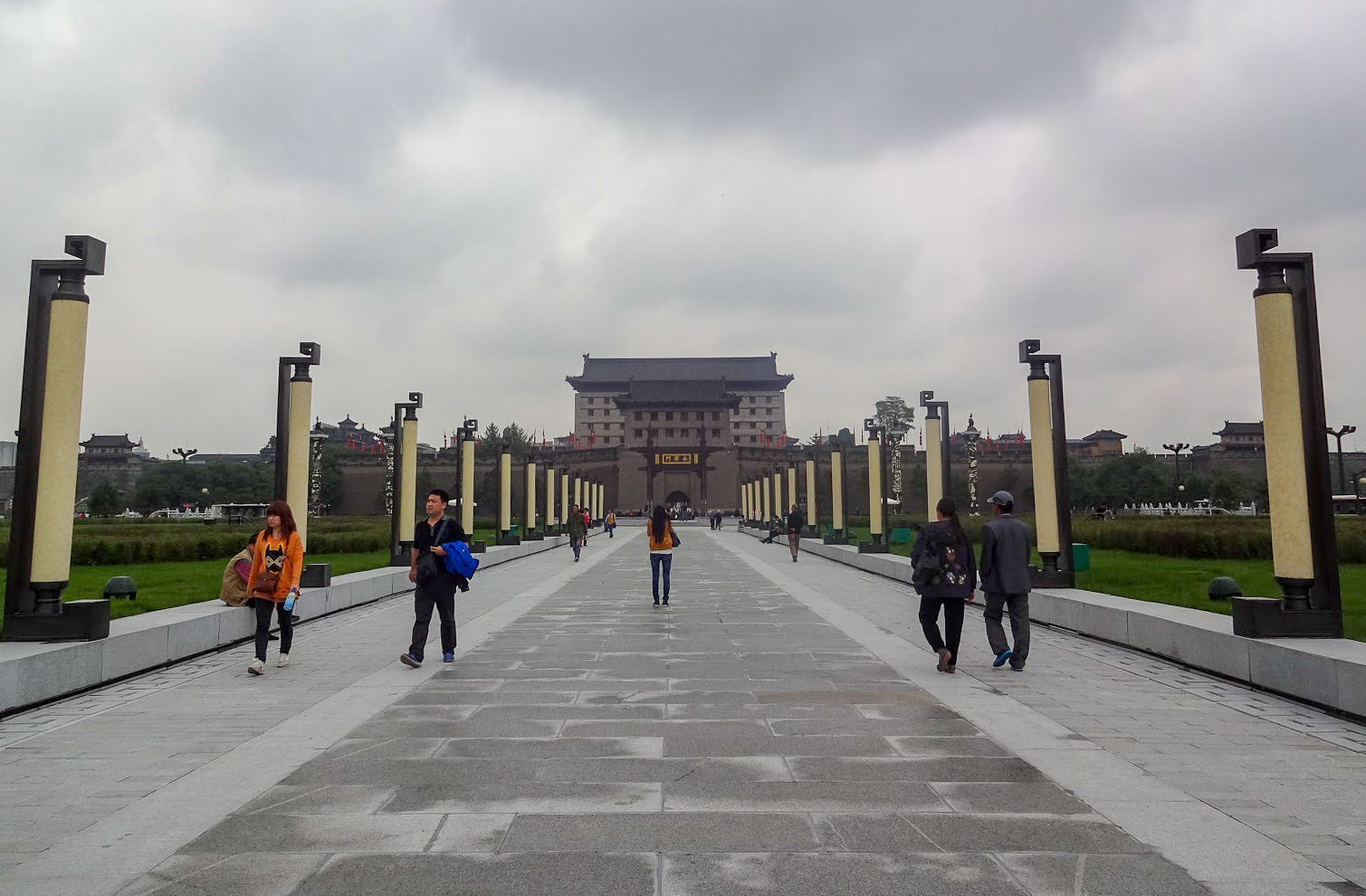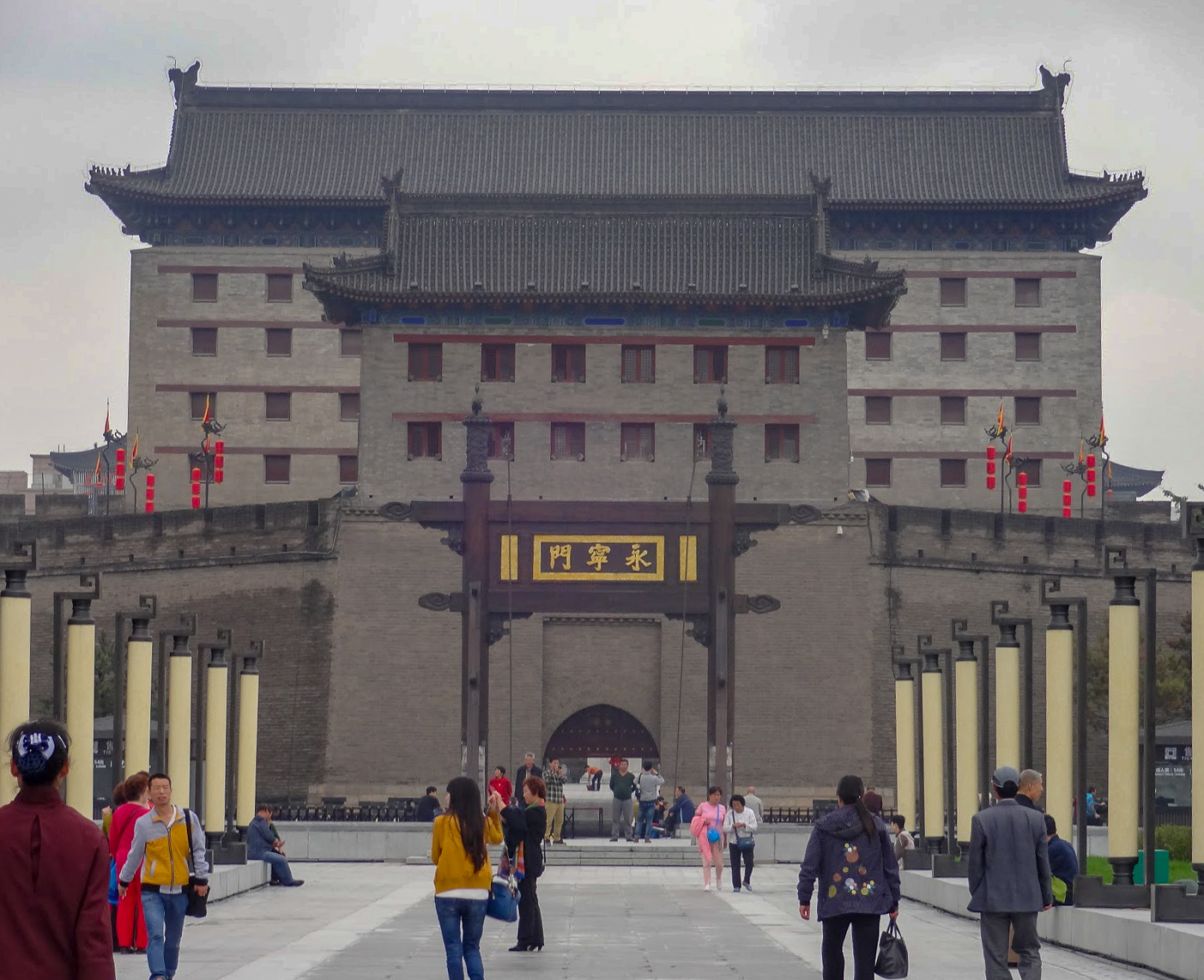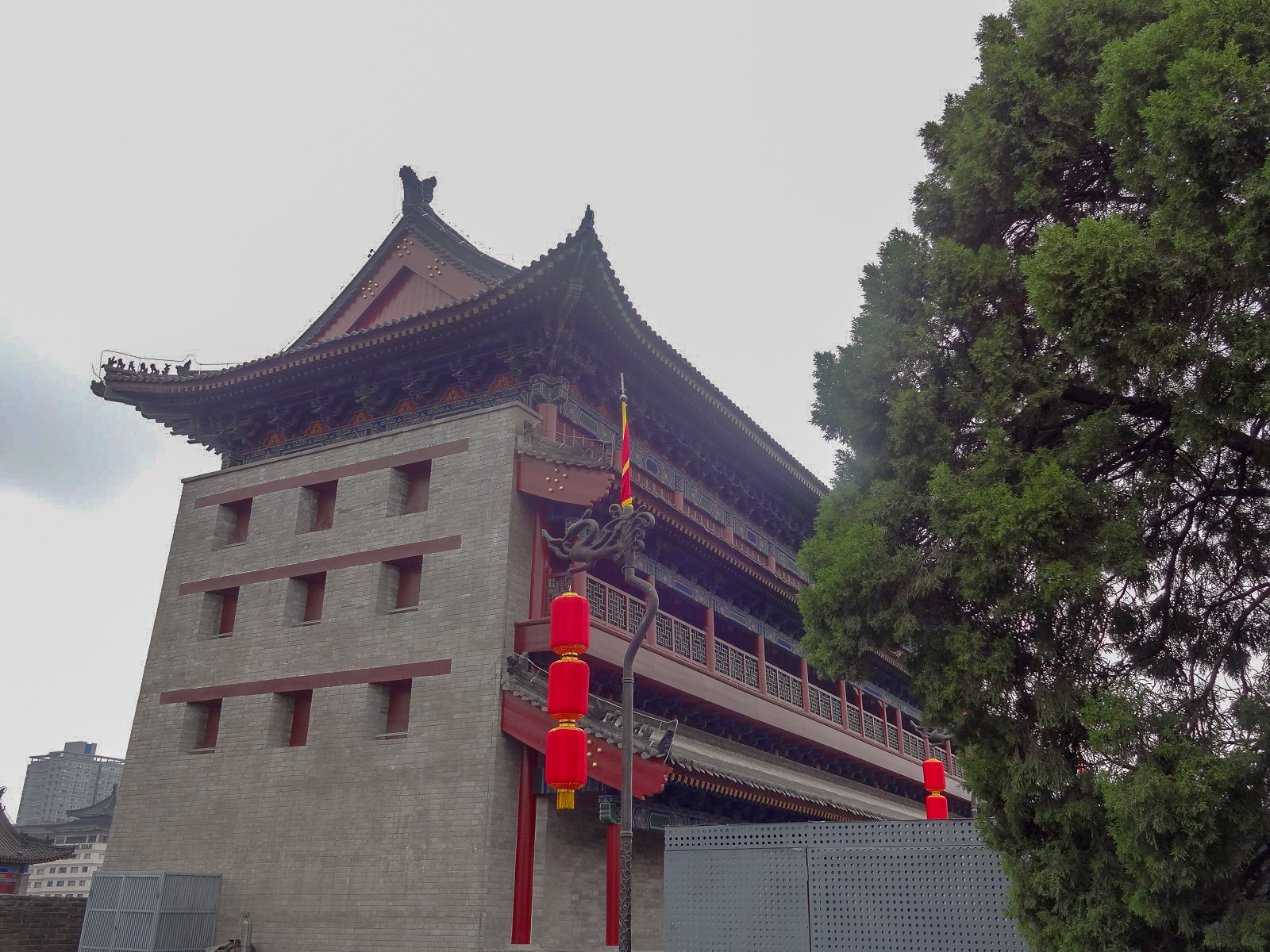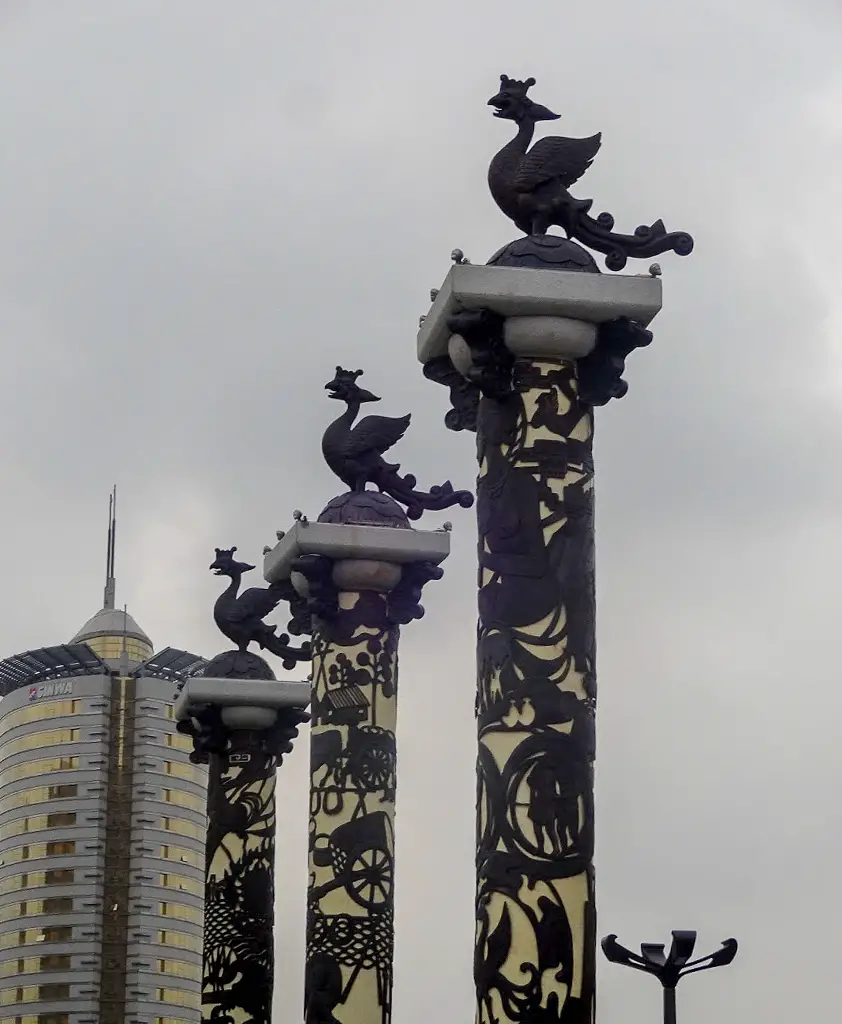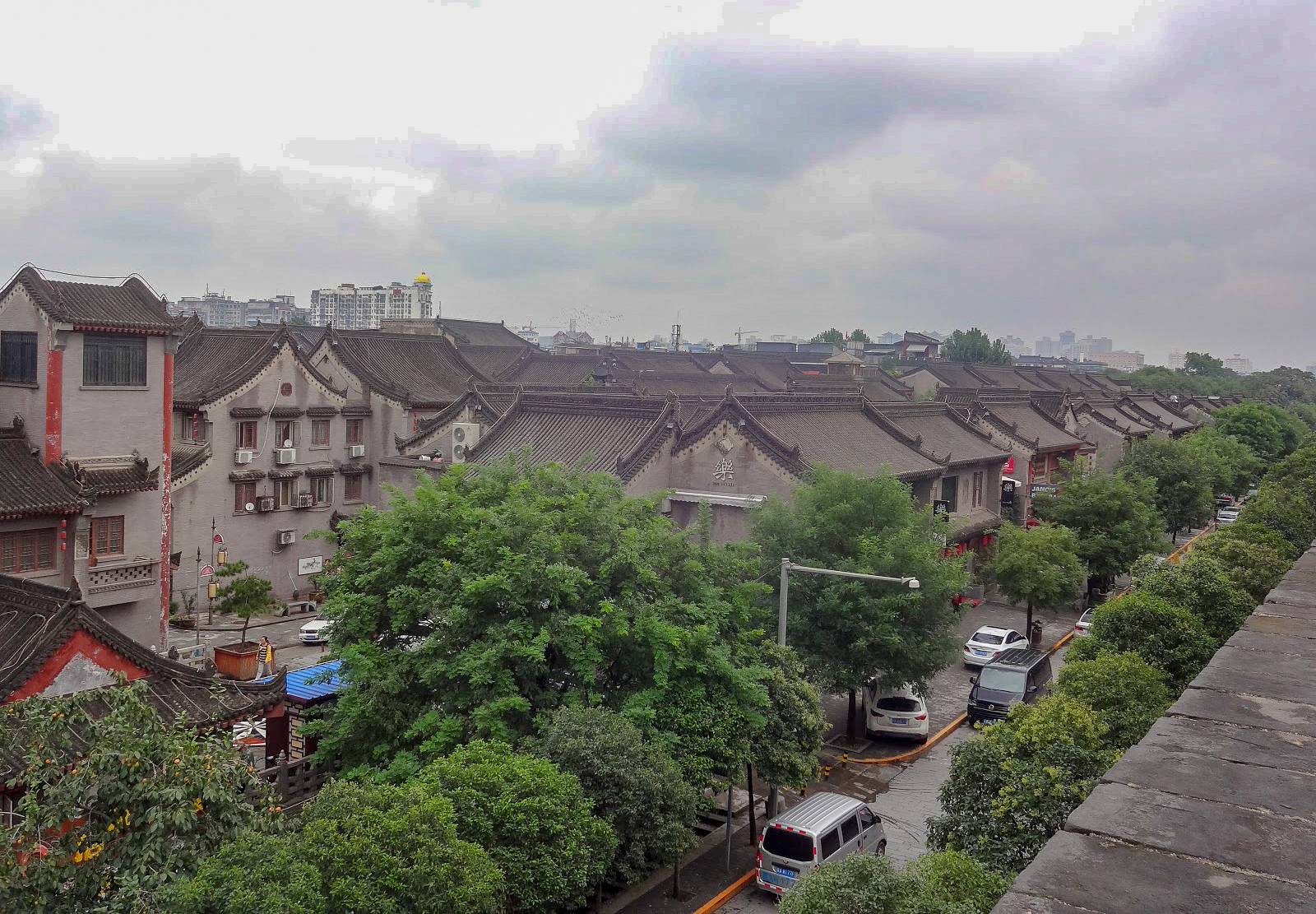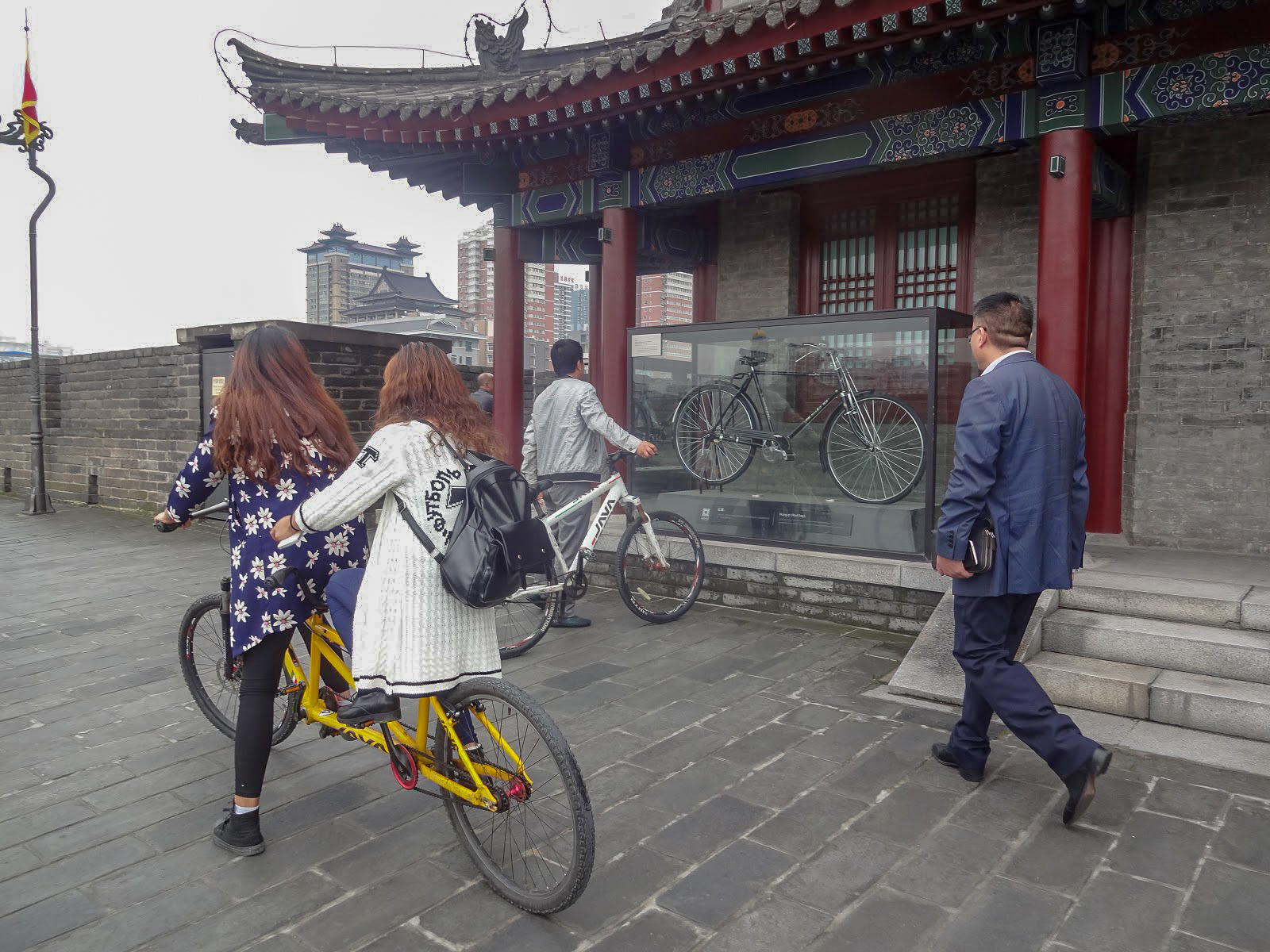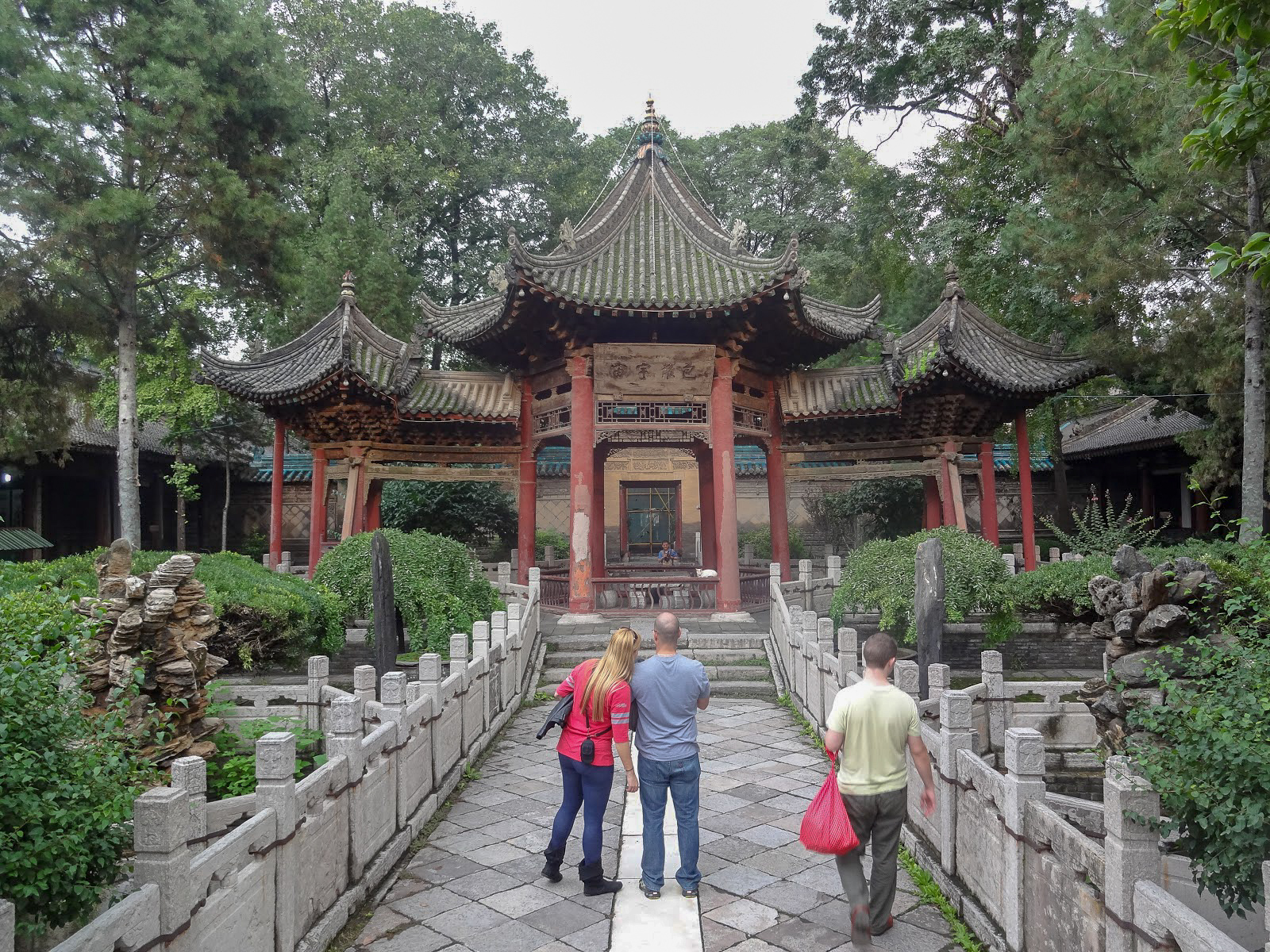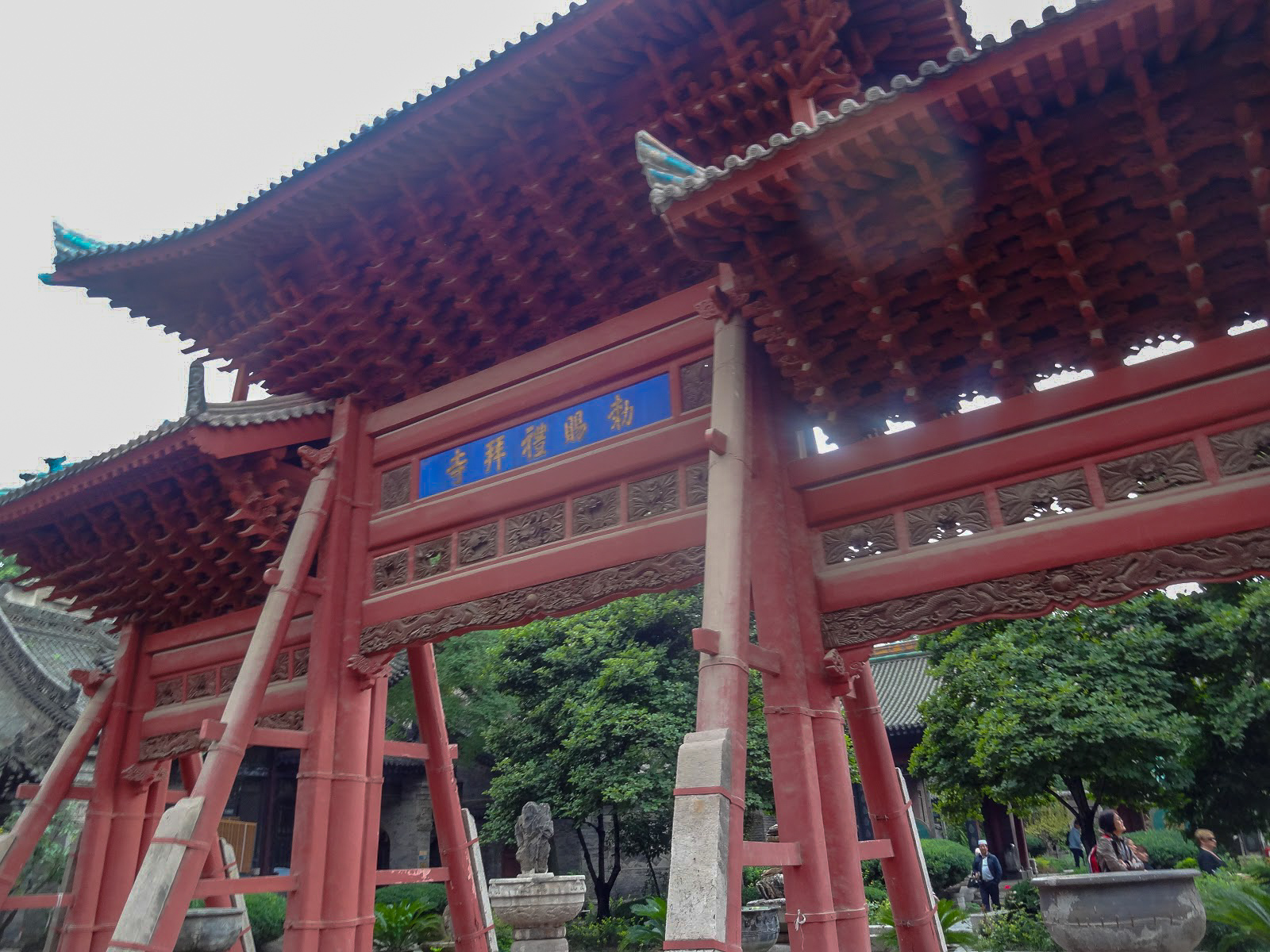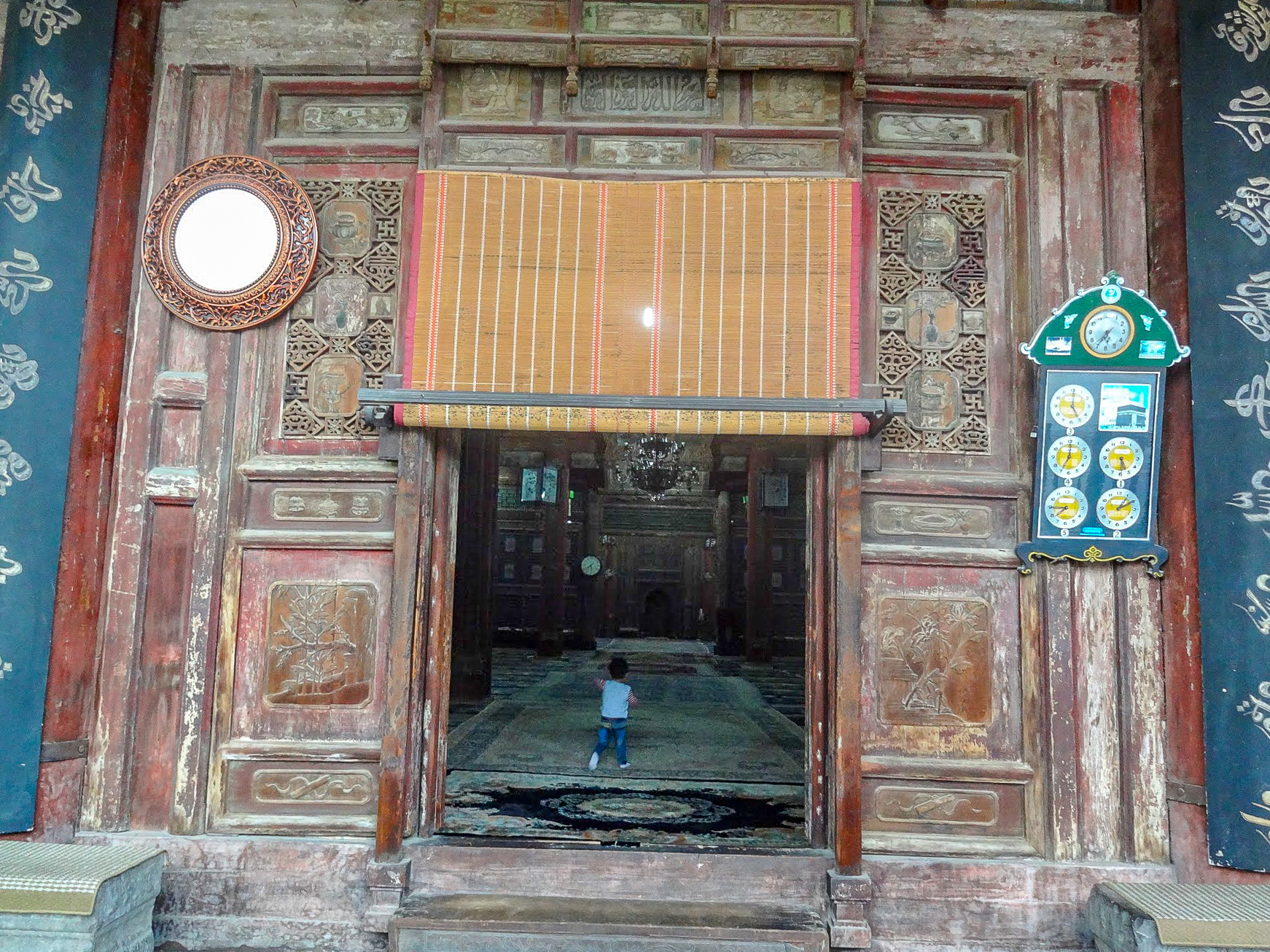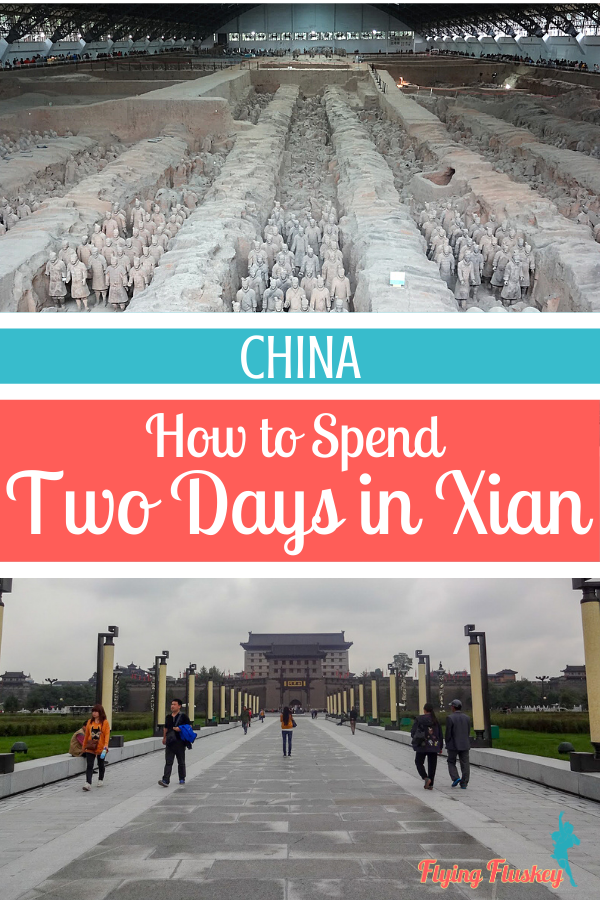Xian is a fascinating city, even for the most amateur of historians, and one of the top three tourist draws in China. From the Terracotta Warriors to the temples and mosques found within in the iconic city walls, there is plenty to explore. So if you only have 2 days in Xian, how do you make the most of your time? This 2 day Xian itinerary will help!
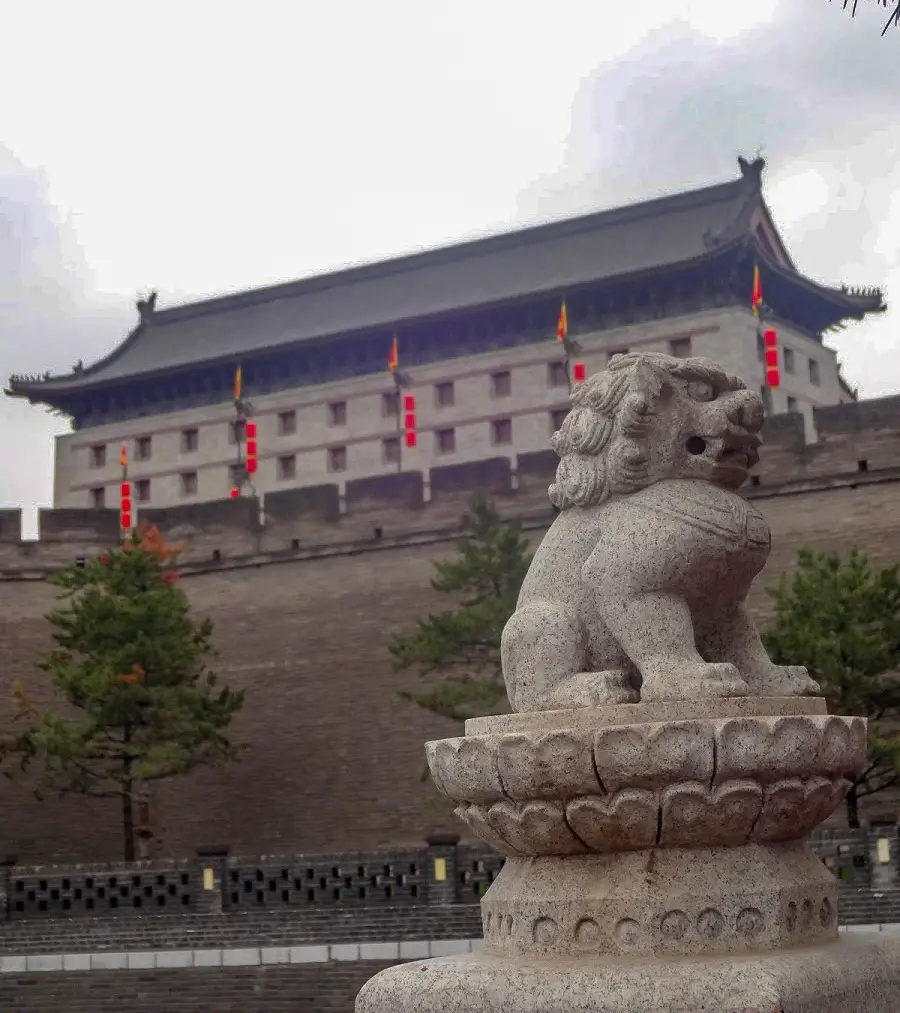
This post may contain affiliate links. By booking through these you will be helping out the blog without costing you a penny extra
Contents
- Xian
- How to Pronounce Xian
- Your 2 Day Xian itinerary
- Day One – Xian City’s Top Sights
- Giant Wild Goose Pagoda
- Back to Town
- The Xian City Wall
- Lunch – First Noodle Under the Sun
- The Drum and Bell Towers
- The Muslim Quarter
- The Great Mosque
- Dinner Time at Beiyuanmen – Xian Food Street
- What to Eat in Xian’s Muslim Quater
- Day Two – The Terracotta Warriors
- Dinner Time
- Information for Your Xian Itinerary
- When to Visit Xian
- How to Get to Xian
- How to Get Around Xian
- Where to Stay in Xian
- Final Thoughts on Your 2 days in Xian Itinerary
Xian
Xian is a city of booms and busts. It was the capital of China for 1200 years and had a population of about a million people before it lost the crown to Luoyang. Over time, Xian became somewhat of a backwater but the discovery of the Terracotta Army in the 1970s, put Xian on the map for travellers. Along with plenty of investment in the1980s by the government, Xian has once again boomed into a metropolis of 8,000,000 people. As the capital of Shaanxi Province, it attracts plenty of business and tourists alike. If you are coming to China, you should definitely include it in your larger Chinese itinerary.
How to Pronounce Xian
“Shee-aan”
When you first start researching travel to China, the names can be a total minefield. A good note to bear in mind in the Romanisation of Chinese characters, “X” is pronounced “SH”.
Your 2 Day Xian itinerary
If you are on a short tour of China, it is absolutely worth visiting Xian alongside Shanghai and Beijing. Some people do a Xian as a day trip, dropping in and going straight to warriors before zooming out again. However, at a minimum, you should spend 2 days in Xian. Set out in this itinerary are the main sights in the city, and time at the famous terracotta warriors archaeological site.
Day One – Xian City’s Top Sights
Giant Wild Goose Pagoda
The furthest South of all the sights you’ll see today, it makes sense to start here and work your way up to the main area of sights.
The 7 storey brick pagoda sits within the grounds of the Buddhist Daci’en Temple. This is one of the earliest Buddhist temples in the far east. As well as worshippers, if you come early in the day you may catch the groups of people dancing or practising tai chi together.
There is an entrance to visit the temple ground, and then an additional fee to climb the pagoda so you can decide how close you want to get. Views from the top are great though so it is worth it…if you fancy the climb up the stairs. There is no lift so just take your time.
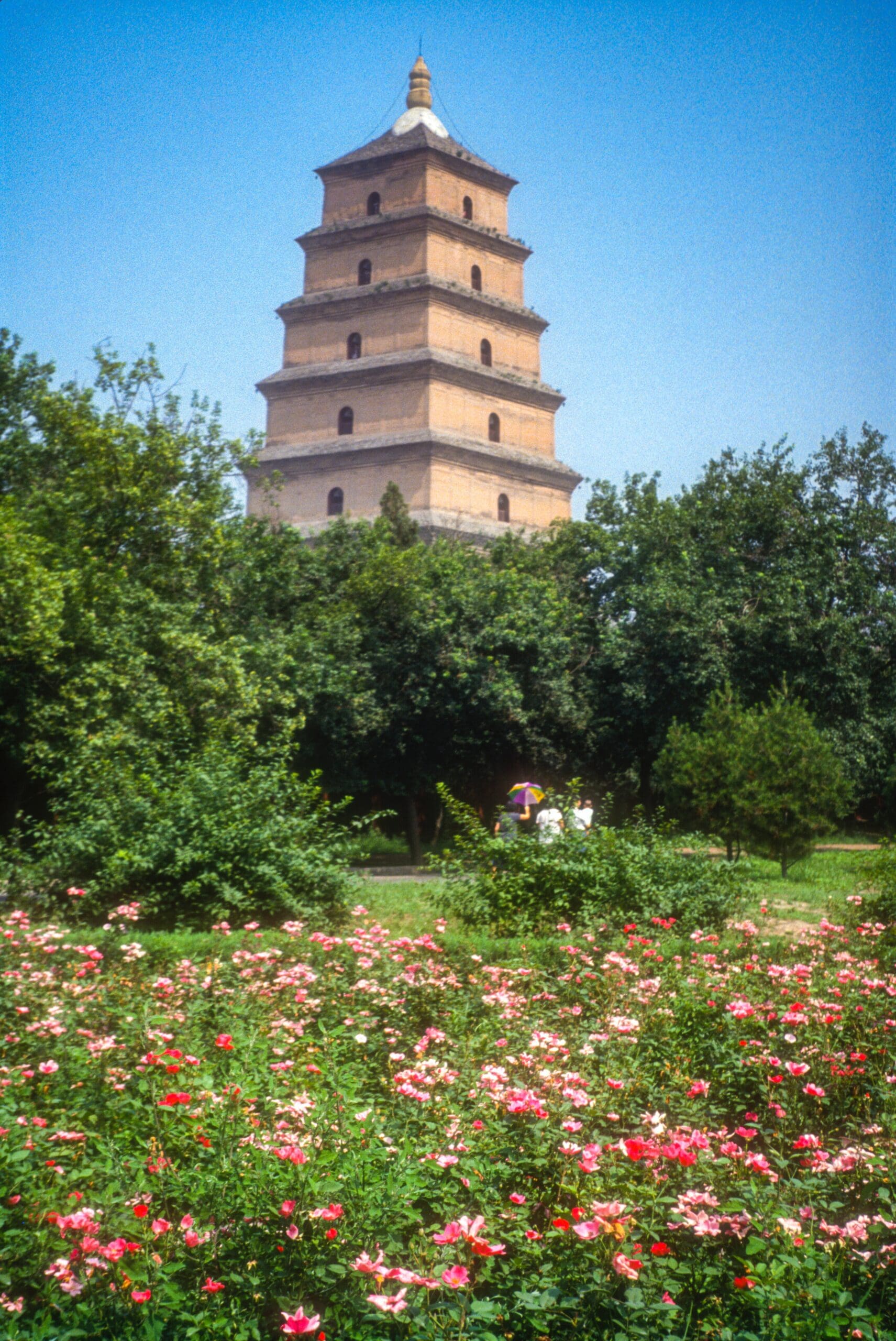
Back to Town
From the Wild Goose Pagoda, take the metro back to the old city. Xiaozhai short walk from here. It is a Line 2 (Red Line) station and runs straight up to the Yongningmen for the South Gate and then on to Zhonlou for the Bell Tower.
The Xian City Wall
Xian’s city walls are a force to be reckoned with. Built in 1370, during the Ming Dynasty, they are still going strong. It is probably due to their immense size (and many renovations). At 12 metres tall, and 15-18 metres thick, they are pretty sturdy. It is an amazing way to see the city from above (yup, old Xian is still very low rise)
Along the 14 kilometre (8.7 mile) route, you will come across watchtowers, four gate towers and cool drawbridges. The watchtowers are spaced at 120m intervals as the archer’s arrows had a range of around 60m.
Walk the Xian City Wall
This takes around 4 hours, depending on how much stopping for snaps you are doing. If you want to shorten this, then catch the metro to Beidajie instead. This is near the Northern gate. From there you can just walk half of it.
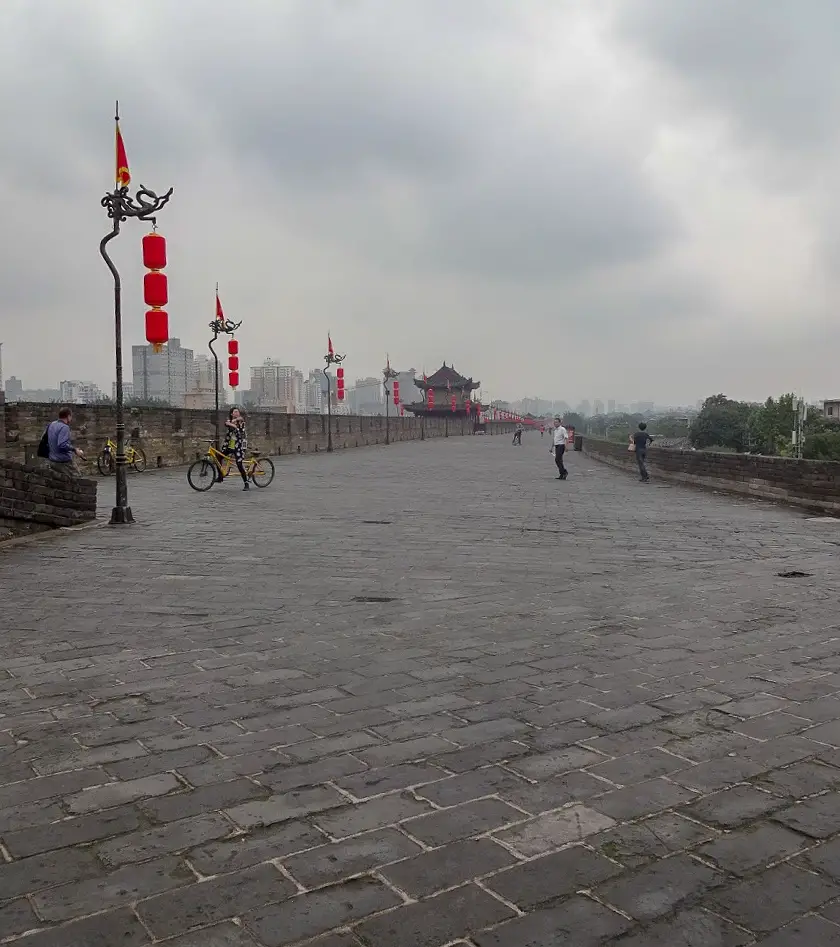
Cycle the Xian City Wall
The other way to see the walls is to take it on two wheels. Not only is it lots of fun, but a great way to get a touch of exercise in (so you can eat more later). The stone walkway is surprisingly bumpy on a bike so be prepared for a slightly juddery ride. Bike hire is available at all four gates but you must return the bikes within the 100 minute time limit or face a small extra fee. Most people end up cycling furiously around the last quarter of the wall in order to make it back on time.
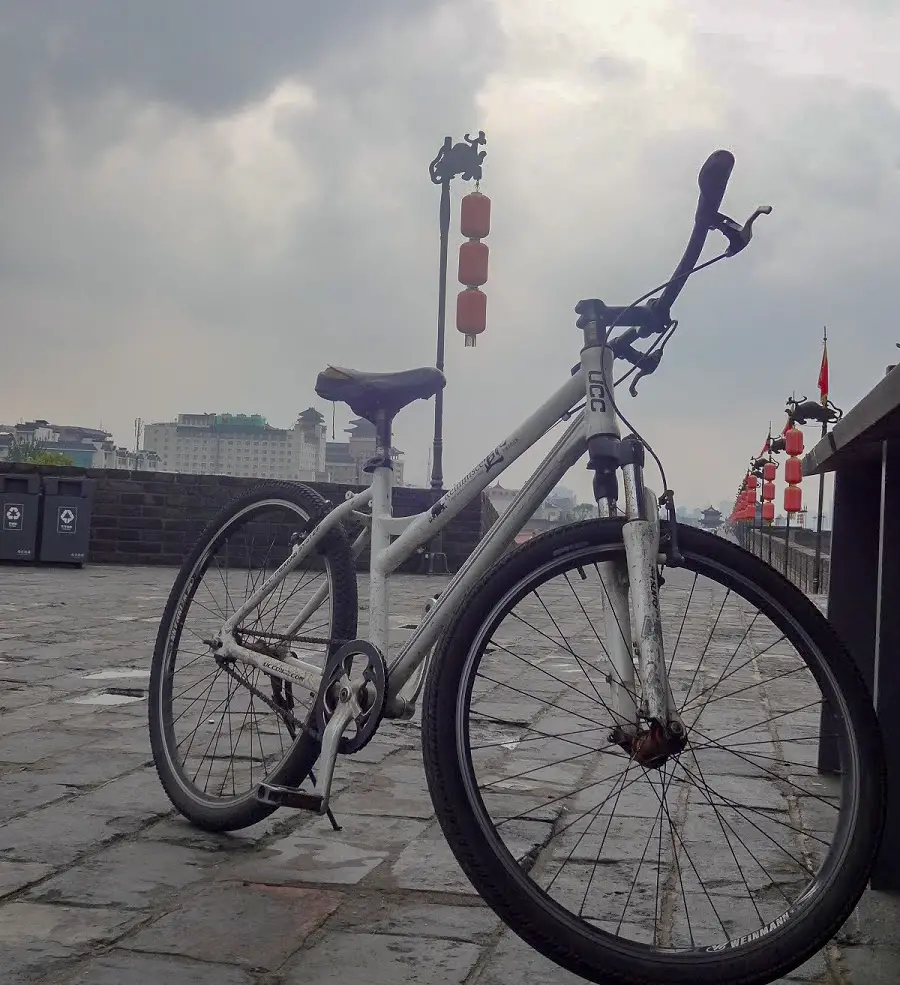
Lunch – First Noodle Under the Sun
Address: 19 Dong Mutou Shi
After all that exercise, you must be hungry and happily it is just a 15 minute walk for some excellent lunch.
First Noodle Under the Sun serves the infamous biang biang noodles of Xian (check out the dinner section to learn all about these tasty ribbons). A single four-metre long noodle is folded into a bowl and topped with deliciousness. Alternatively, their dumplings and chicken skewers are passable and better than that, their vegetable side dishes are surprisingly good. Alongside your lunch, you can enjoy a cold beer (a rarity outside of Western restaurants).
The Drum and Bell Towers
Xian’s two famous towers are a five minute walk from each other. With their strong colours, and brightly illuminated evening wear, they look like they were built a few years ago but they are actually hundreds of years old. (Even some of the drums on the drum towers are hundreds of year old)! Both towers were originally built in the 14th century with renovations in the 18th. These two pagodas marked the day in Xian. The bell tower housed a huge bell that was rung to mark the morning, and the drum tower had a huge drum punctuated sunset. You can enter both towers and if you visit between 14:30 – 17:30 they will both be hosting live music.
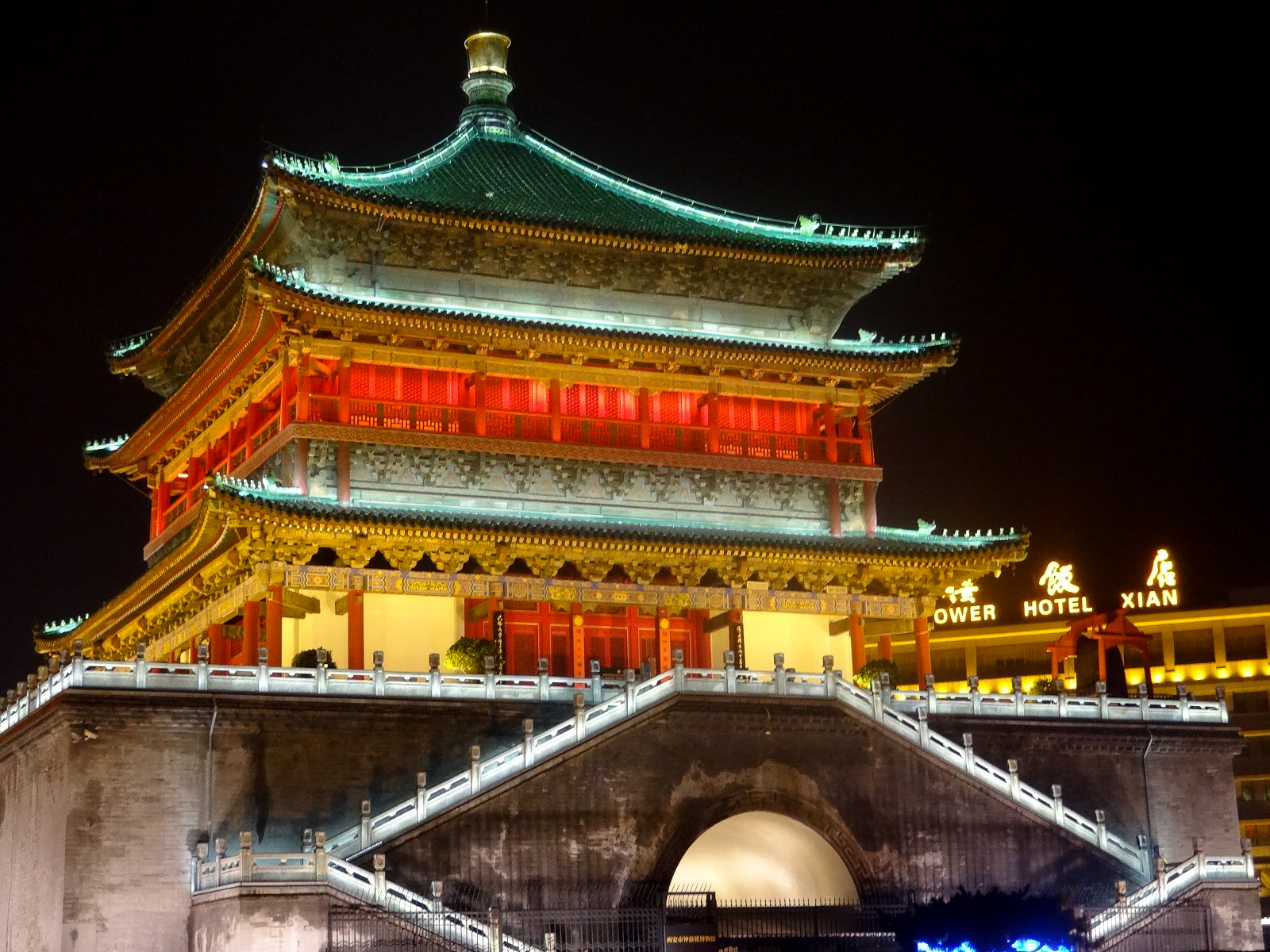
The Muslim Quarter
Stretching north from the drum and bell towers is the area known as the Muslim quarter. Xian marked the end of the Silk Road for hundreds of years and so travellers and immigrants made their way here from the west. In the 7th century, a Hui contingent settled here and brought their culture with them. This creates a pocket of unique food and architecture.
The Great Mosque
Run the gauntlet of souvenir stalls to reach one of the most relaxing places in Xian. This large mosque, with its beautiful blend of Islamic and Chinese architecture, is an important piece of Muslim history This is the oldest and biggest mosque in China. Construction started in the 6th century by settlers from Persia. It has been added to many times leading to an interesting mix of styles.
You’ll find the classic trappings of a Chinese temple. Tiled rooves and traditional arches almost disguise the fact this is a mosque. The prayer hall faces west (towards Mecca) and although you can’t go in, you can peek through the doors.
Dinner Time at Beiyuanmen – Xian Food Street
At first glance, this area seems like a manufactured tourist hotspot but it has long been a great place to grab a snack. Locals pop by just as much as the tourist population.
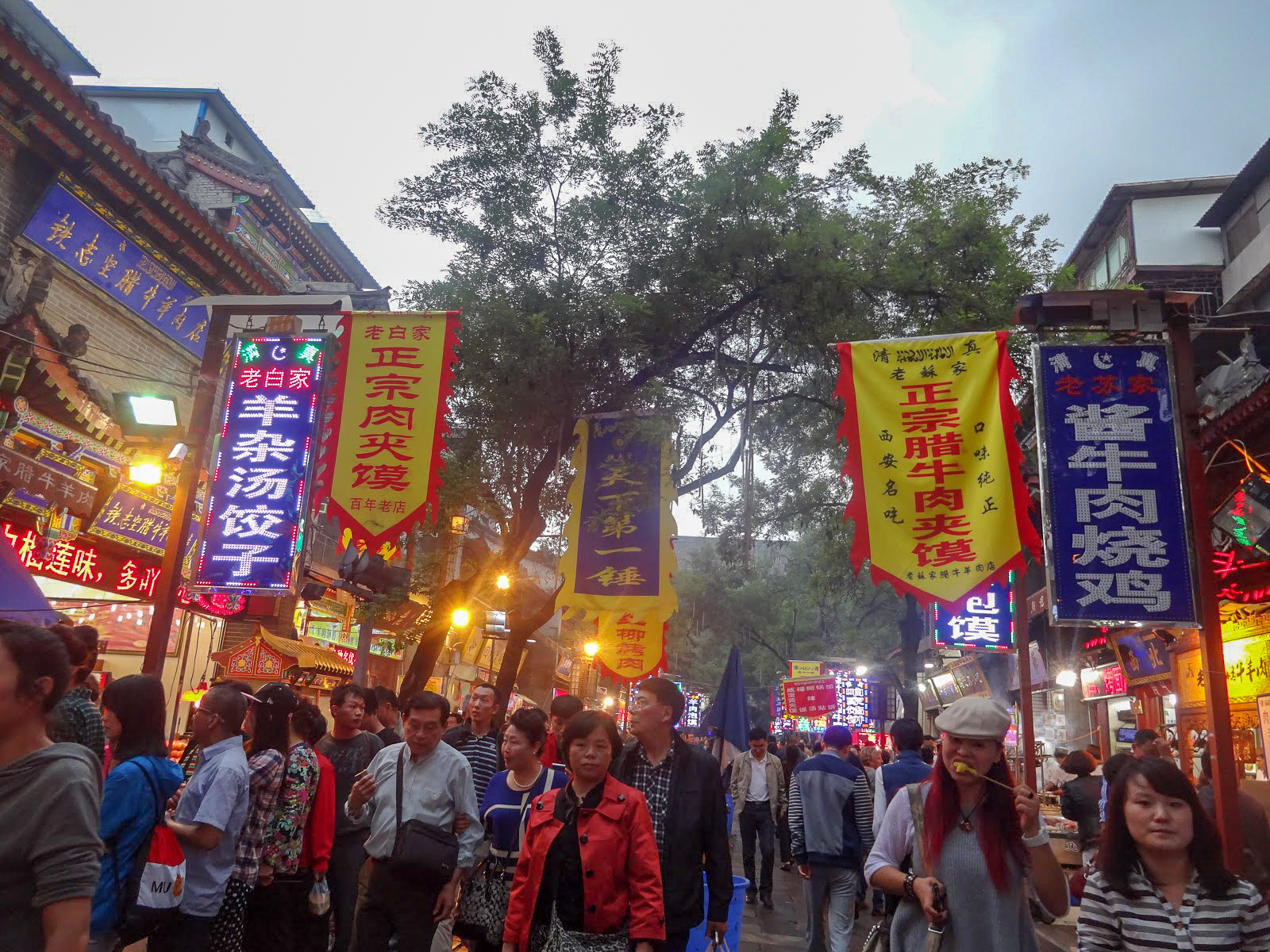
The Shaanxi cuisine found in Xian is unlike the options you’ll find further east in Beijing or Shanghai so if you only have 2 days in Xian, you should make an effort to seek it out. Helpfully, the Muslim Quarter boats a walking street that is absolutely packed with restaurants and stall serving just that.
Xian’s connection to the silk road and its population of Muslims means you’ll find a lot more mutton and lamb used here, as opposed to the pork that is considered a staple elsewhere. You’ll also find that there is a lot less sugar used here so sauces tend to be heavy and savoury, often with some spice, rather than sweet and sticky.
Along Beiyuanmen’s length, you are spoilt for choice. From unidentified meat on sticks, to proper sit down restaurants with confusing English translations on the menu there is plenty to choose from.
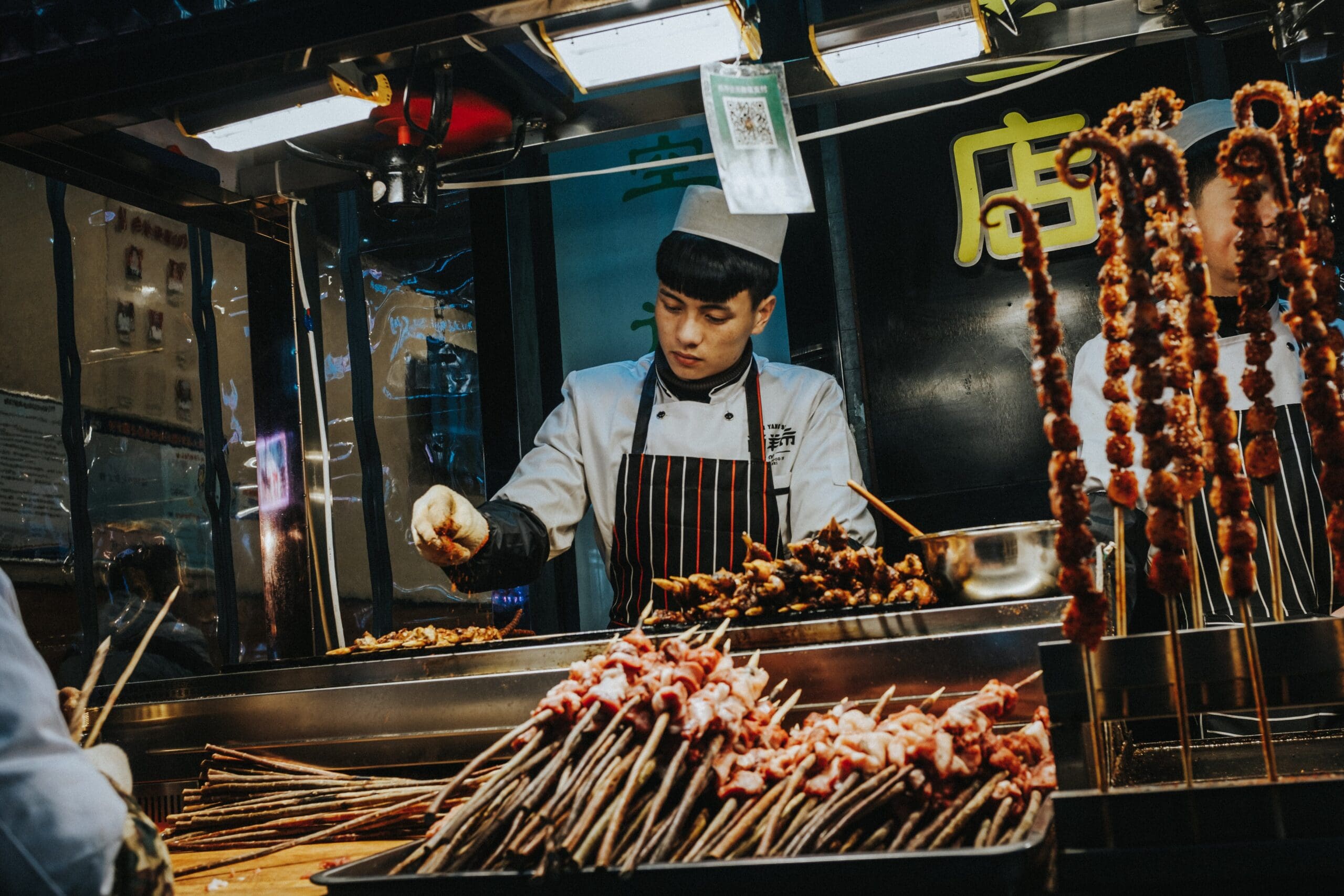
What to Eat in Xian’s Muslim Quater
Biang Biang Mian
This is by far Xian’s most famous dish. That is because Binng Biang noodles are delicious and quite the novelty. When you order a bowl, the chefs will take small balls of noodle dough and hand stretch them into the characteristic shape. Once they have stretched them on the work surface, they pick up the strips and flick them u and down to increase the length. The name biang biang comes from the sound of the cooks thwacking the dough against their counters. Biang Biang noodles are flat, wide wheat noodles and traditionally eaten with fiery chilli oil, making them ideal if the weather is a cold.
Fun Fact: Biang is the most complex character in the Chinese alphabet. It takes 57 strokes!
Pao mo
Although Biang Biang noodles is the dish that most westerners have heard of it is actually Pao mo that holds the title of “Xian’s Signature Dish”. A hearty lamb or mutton soup (sometimes you’ll find it with beef) with hunks of the local mo flatbread soaking in the juices. Some restaurants allow you to tear your own flatbread to your satisfaction before the broth is added. This means you can opt for nice big chunks (like croutons) or tiny scraps adding more to the texture of the soup. This is seriously filling considering it is labelled a soup…it is more akin to stew.
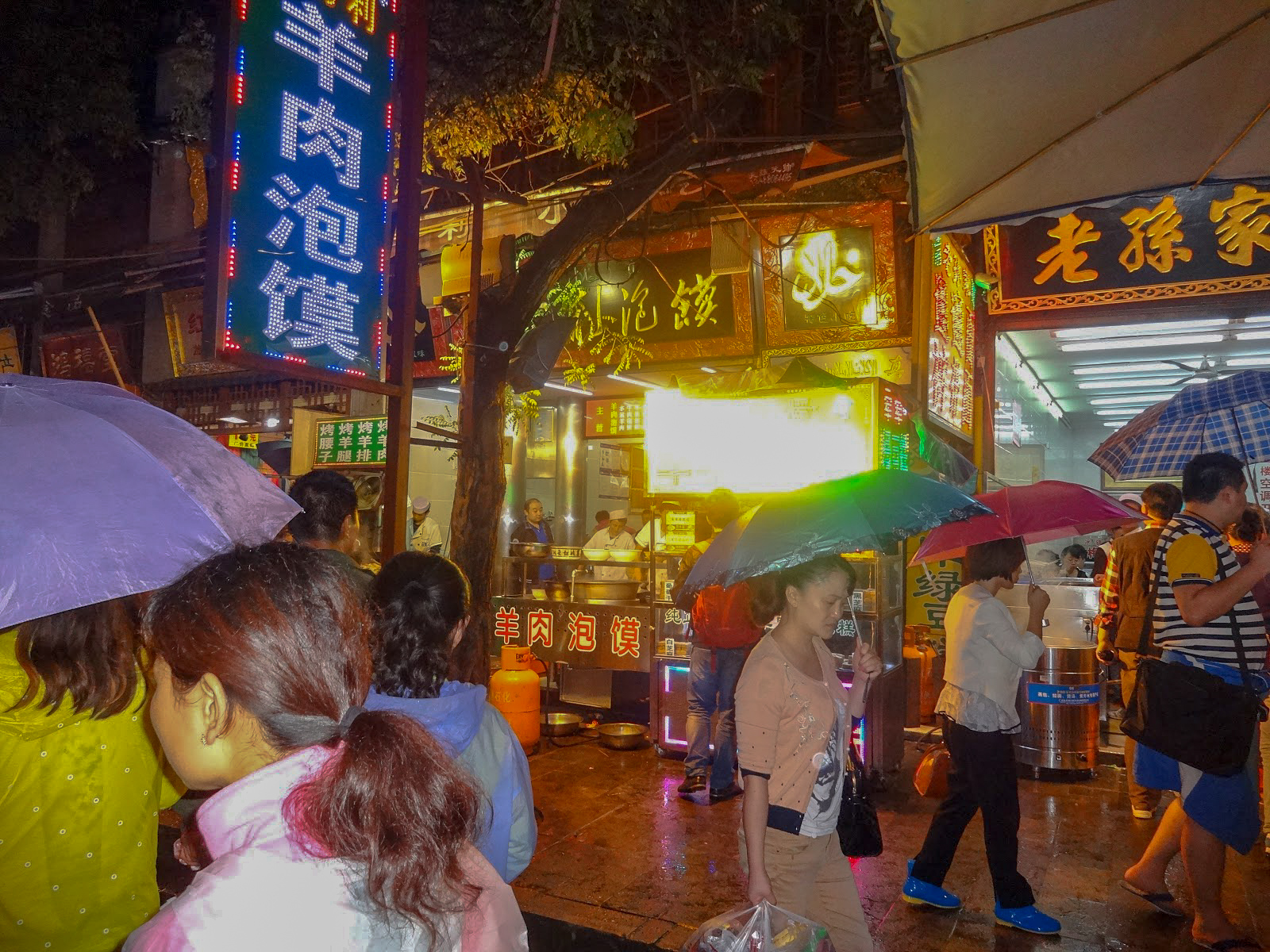
Roujiamo
This Xian staple is great to grab on the go. You could look at this is as either a kofta sandwich or a Chinese hamburger. In the rest of the country (and the city), they are referred to as roujiabing and have pulled pork in. In Xian, lamb or beef is marinated for hours, pulled apart and then stuffed into a mo flatbread. Cheap, tasty and not too intimidating for the nervous eater.
Dessert – “Stretched and Hammered Sugar”
This is a great way to end a stall crawl along Beiyuanmen in part because it is sweet and great to nibble as you walk home, and in part because watching the chefs performing their sugar-stretching is so much fun. Huge strings of candy are pulled, wrapped, swung and pulled again, all whilst avoiding the dirty pavement. From here, the warm sugar is sprinkled liberally with chopped nuts which are noisily beaten into the candy with huge wooden mallets. The whole thing is pure food theatre.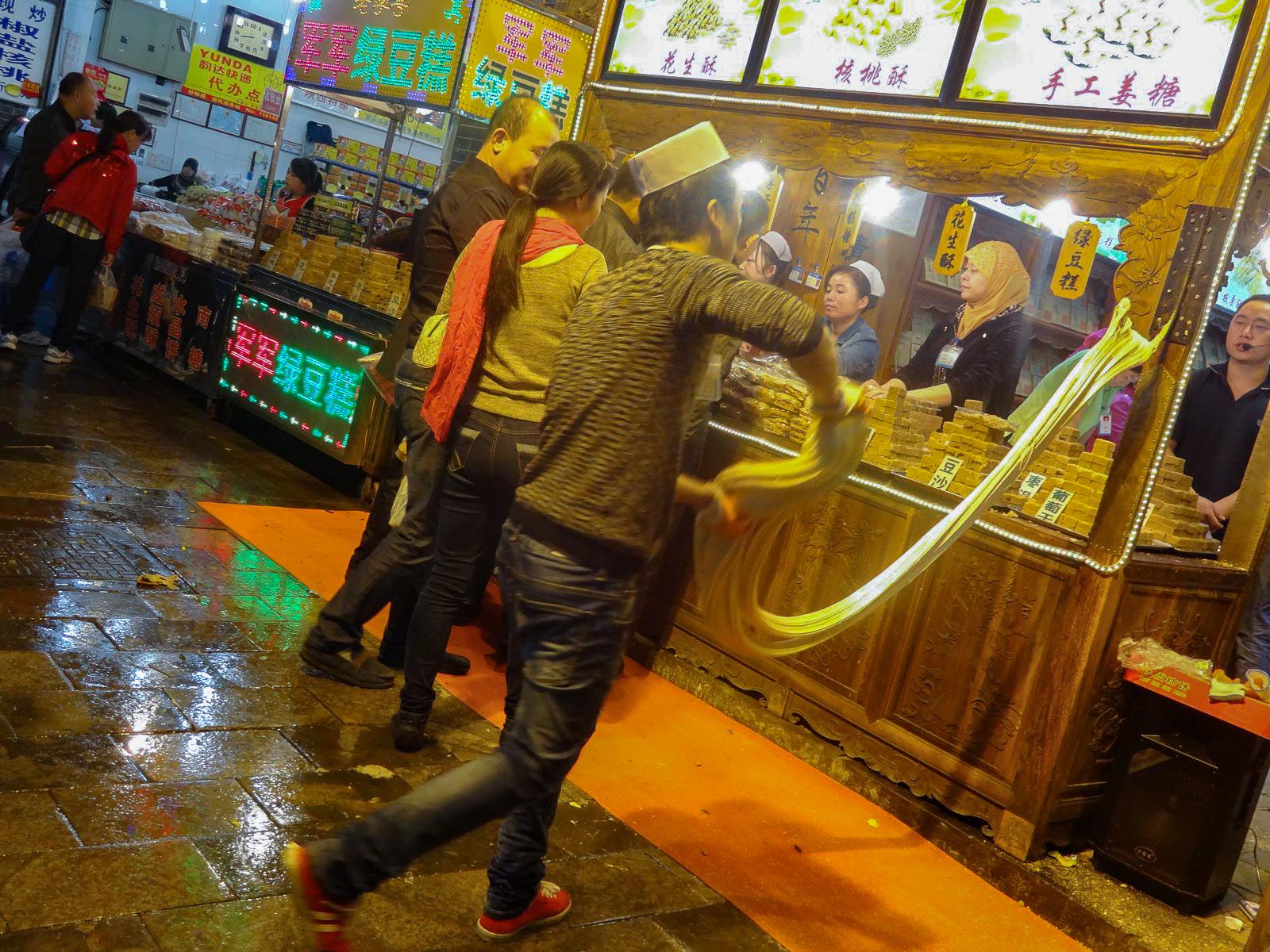
Day Two – The Terracotta Warriors
The Terracotta Army is the hottest ticket in town and the reason most tourists come to Xian. Today is dedicated to visiting the site.
We have written a full guide to visiting the Terracotta Warriors which you can see in the link below. As such, this will be a brief overview.
The sight of 1000 soldiers, standing at 1.8m tall, staring you down is awe inspiring at the best of times…but when they are over 2000 years old and made of clay, it is even more magnificent.
The Terracotta Warriors museum is a site an hour from central Xian but a world away. 2000 years ago, a vast army and burial mausoleum were constructed for the first emperor of China. The first figures from here were discovered in the 1970s and excavations here have been ongoing ever since. Thousands of clay soldiers have been uncovered, along with chariots and horses made of bronze and terracotta. The whole site is incredible and absolutely worth a visit.
How to Get to the Terracotta Warriors
If you are travelling on a budget, you will be happy to hear that it is really easy to reach the site that sits 30km east of Xian. Hop on green bus 306 from Xian Railway Station and you’ll reach the Terracotta Warrior Museum in an hour.
Dinner Time
Of course, you could head straight back to Beiyuanmen, and we wouldn’t blame you, but there are a couple of other foodie options to consider a short walk south from Xian Railway Station (if you are coming back on the bus this handy)
Haidilao Hot Pot Cheng
Address: JieFang Road 63, DongXin Street MinLe XinDuHui 4 Floor,
This is just one branch of the immensely popular hot pot restaurant. Guests sit around a table with a tub of gently steaming broth. You choose a few ingredients from the menu and chuck them in until they are cooked enough to munch. Add to this the sauce bar full of flavourful condiments (including red hot chilli concoctions) and you have an ideal dinner on a chilly night. Staff at this particular branch show oodles of patience as they guide visitors through the menu, translating and demonstrating. It is a fun and sociable dining experience.
Cyclist Restaurant
Address: No.25 Huangcheng East Road
If you are craving some more European fare, Cyclist is a surprisingly good place serving up good pizza, steaks and even lovely fresh salads. If you have been in China for a while, it can be so relaxing to see a menu full of familiar items, served by English speaking staff and with good beer. This is especially true if you know the food is going to be good.
Information for Your Xian Itinerary
When to Visit Xian
The best time to visit Xian, is when the weather warms up a little. March to November is best.
Spring – Flowers in the Great Mosque courtyard burst into bloom and the days are nice and warm.
Summer – Taking in the city walls is tough in the summer sun as there is very little shade. However, if you are a sunny bunny, you’ll be fine. It is pleasant to explore the Muslim Quarter in the evenings when it is warm. It can be quite rainy so bring a brolly for those sun showers.
Autumn – Clear skies and warm day with crisp, cool evenings. This is high season so expect crowds.
Winter – Cold and foggy, It is not ideal sightseeing weather.
How to Get to Xian
Planes
Trains
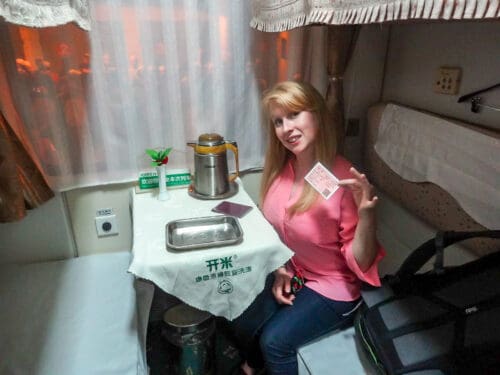
How to Get Around Xian
Metro – The Metro connects all major sights and is cheap, fast and clean. Make sure you have change for the ticket machines which are helpfully in English. 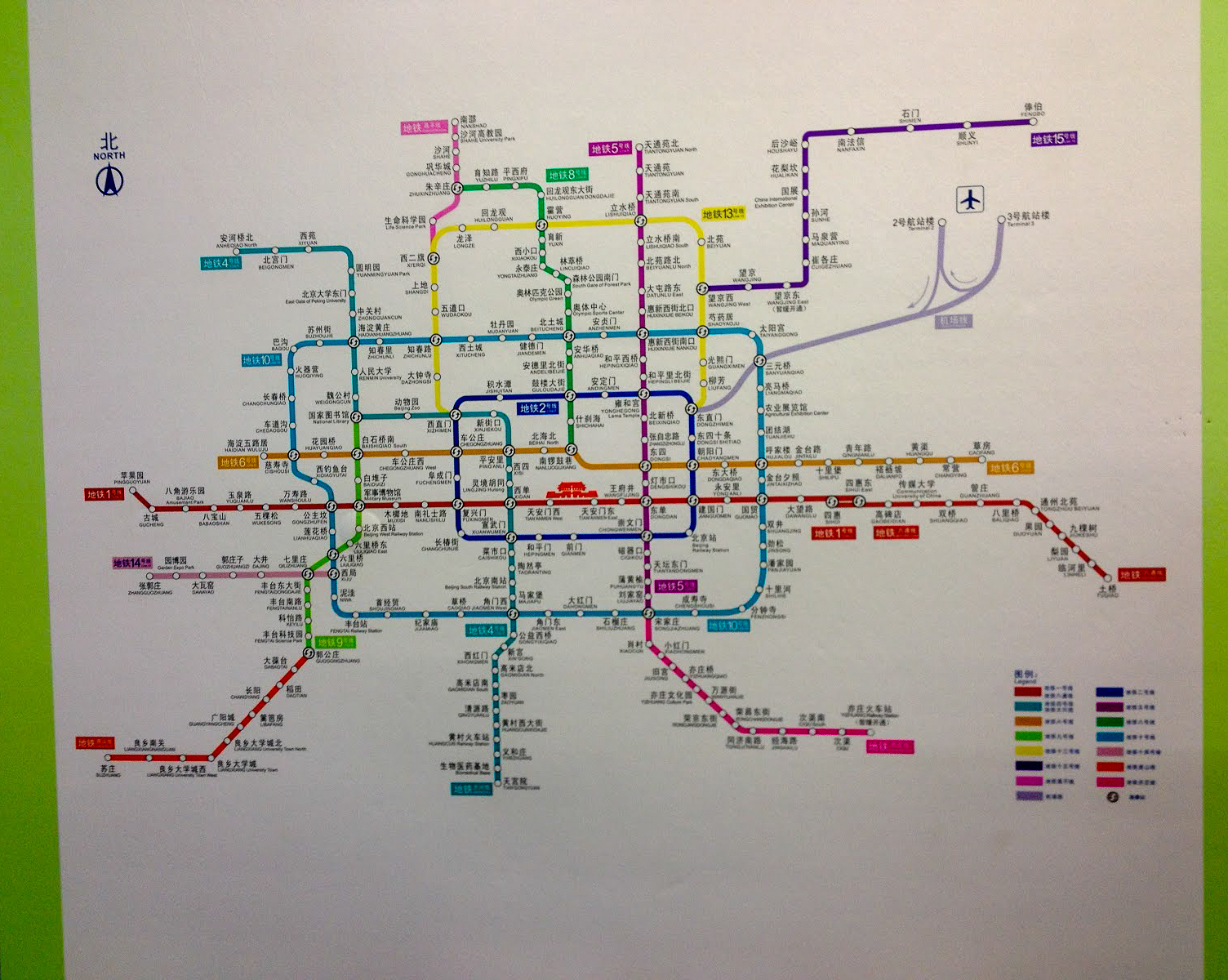
Bus – Buses are cheap but a little slower as they can get stuck in rush hour. Again, have change handy for paying the fare.
Taxi – As mentioned, taxis are not well regulated. It is a good idea to have the name of your hotel or destination written in Chinese to show the driver. Ensure the driver uses the meter. Finally, don’t use a big 100RMB note. Have smaller change as there is a scam involving “fake money” where the driver pretends you money is fake and when they had it back they have actually given you a fake.
Where to Stay in Xian
On a Budget – Travelling With Hostel (previously Green Forest Hostel)
On a Budget – Hantang Inn
Midrange Option – Eastern house Boutique Hotel
Splash the Cash – The Sofitel Legend People’s Grand Hotel Xi’an
